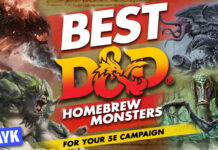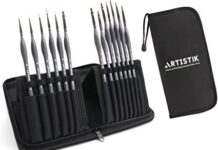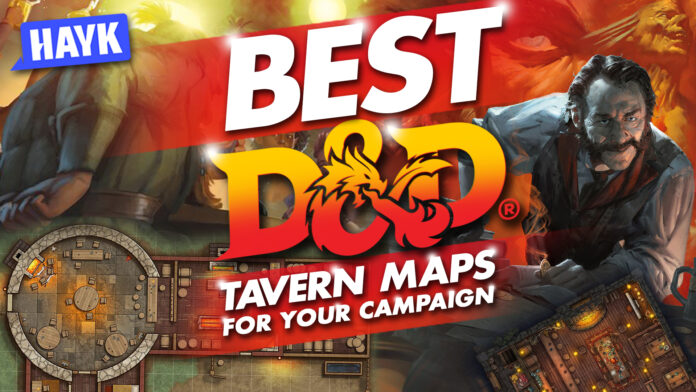
The tavern is the usual starting point of any D&D campaign or adventure. Without a tavern in a campaign, the players might feel stressed or anxious. After all, most players want a refreshing drink or a soft bed after a long day of adventuring or exploring.
If your first game session is coming up and you don’t have an idea for a tavern, you can check out the options presented in this article. We’ve included the most popular D&D tavern ideas along with some useful tips for making your own tavern.
The Most Popular Types of D&D Tavern Maps Explored
The Classic Tavern
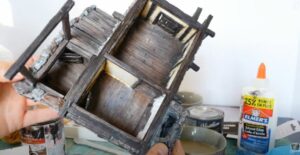
Pros:
• Easy to use and make
• Lots of sources to gather from
• Contains all amenities right at the start
Cons:
• Too bland for some players
• DMs need extra work to upgrade basic taverns
Best Campaign Themes:
• Low fantasy
• High fantasy
• Medieval
The classic tavern is unbeatable because of its simplicity, ease of access, and a homely ambiance. It’s also easy to describe a classic tavern because there are no extra sections or rooms to worry about.
However, simplicity can only go so far. Seasoned D&D players might feel bored with a classic tavern, and they might look for additional features. If your players want an expanded tavern, simply tell them that the development is underway. The development will give the players something to look forward to, and they might also help the project through their efforts and resources.
The Treehouse Tavern
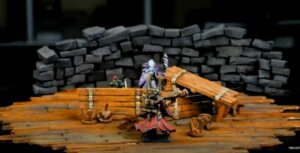
Pros:
• Scenic views for roleplay
• Unique downtime experiences
• Interesting opportunities for lore
Cons:
• Making the tavern design is laborious
• Tactically disadvantageous location
Best campaign themes:
• High fantasy
• Low fantasy
• Sword and sorcery
A treehouse tavern is located on top of a massive tree, protected by strong branches and a thick canopy of leaves. Simply imagine the Inn of the Last Home from the Dragonlance setting. One of the advantages of a treehouse tavern is the scenic views that will make roleplay moments more interesting.
Despite its beauty, the treehouse tavern can be difficult to create and set up. You need tons of materials to make a treehouse tavern alive in physical D&D sessions. In a VTT program, however, you can just upload a detailed picture and an isometric map that shows that tavern’s interior.
The Floating Tavern
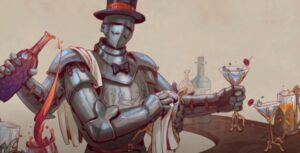
Pros:
• Unique experience for players
• A convenient way to escape or travel
• A great place for conflicts or plot hooks
Cons:
• Potentially dangerous location
• Difficult to set up in physical sessions
Best campaign themes:
• High fantasy
• Steampunk or Dieselpunk
• Cyberpunk
Floating taverns are more unique than floating cities. There’s almost no reason for a tavern to stay afloat unless it is hiding something phenomenal or ground-shattering. If you want to use a floating tavern in your campaign, make sure that you have a sub-quest storyline ready.
A floating tavern is not just a narrative tool. It’s also a way for players to escape from their pursuers. If the players love to travel the world, they can just hitch a ride in a floating tavern as long as they can pay for lodging.
In terms of tactical positioning, a floating tavern is a liability. One clear shot from an experienced mage can bring down a floating tavern. Players should have a remarkable defensive plan if they intend to stay in a floating tavern for a long time!
The Mobile Tavern
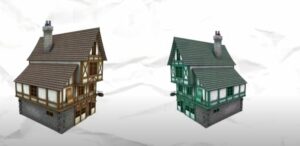
Pros:
• Great location for roleplay
• Easy to set up plot hooks
• Unique drinks, foods, and items
Cons:
• Tricky to assemble and set up
• Online maps might be cramped or small
Best campaign themes:
• Sword and sorcery
• Steampunk
• Surreal
Mobile taverns are few and far between. You will rarely find a mobile tavern in a fantasy setting because it’s more common in steampunk adventures. It also takes a deeply creative mind to run a mobile tavern.
Before using a mobile tavern, you should determine its source of movement. Is the tavern built on the back of a large animal? Is the tavern powered by a slow engine? Why should the tavern move all the time? These are just some of the questions that you must answer. If you analyze the questions well, you’d realize that they can be tied to your campaign progress.
It’s not easy to find a mobile tavern structure for physical D&D sessions. Very likely, you’d end up with a custom piece that costs more than $100. In online sessions, mobile tavern maps might look constricted because of the external space needed. To solve this minor problem, you can just describe the mobile tavern briefly and move on to other crucial details.
The Monster Tavern
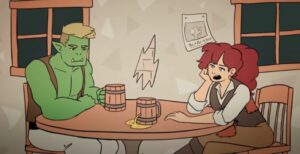
Pros:
• Fantastic location with friendly monsters
• Interesting encounters and events
• Exotic menu and characters
Cons:
• Requires tremendous DM prep
• Players might feel anxious around monsters
Best campaign themes:
• Sword and sorcery
• High fantasy
• Pokemon-inspired campaign
The monster tavern is similar to any other kind of tavern. However, the only difference is the fact that this tavern is run by intelligent monsters. Perhaps the monster tavern can signify the way monsters are integrated into the greater community. The best thing about the monster tavern is its inherent uniqueness and lasting appeal.
It’s somehow difficult to use the monster tavern because of the extra miniatures and terrain pieces needed. You may also need to describe the monster staff in a normal yet less imposing way. Also, players might feel the urge to attack monsters, leading to a great conflict even before the first planned encounter!
Quick Tips on How to Make a D&D Tavern Map
Do you want to build a custom D&D tavern map? In this article section, you will learn about some important tips on making a tavern for your D&D campaign.
Visualize A Small Starting Point
If you’re planning to make a detailed tavern, don’t focus on big sections right away. Rather, you must start small and build your awesome tavern along the way. Connect your tavern’s progress to the overarching narrative and your players will appreciate the effort.
Get Inspiration from Real Taverns
More often than not, DMs will always benefit from analyzing real-life examples of locations and establishments. Around the world, there are hundreds of unique taverns that all DMs can refer to. If you’re pressed for time, just search for these taverns and note down their most exciting features.
Aside from big real-life taverns, you can also take a look at hole-in-the-wall restaurants or ‘mom and pop’ locations. These unique places carry the personalities of their owners, and they even have remarkable foods that can stimulate the senses.
Don’t Hesitate to Reskin and Reflavor
In D&D or any tabletop RPG, reskinning and reflavoring are important techniques. If a DM knows how to reskin content properly, he or she will have an easier time running most campaigns.
If entire stories can be reflavored in a snap, a tavern is definitely not exempted. Just pick a tavern from a body of fiction and change its main features and general structure. Now, embrace the reflavored tavern as your creation and use it in all of your campaigns!
Create A Simple Yet Beneficial Menu
A tavern without a menu is not worth the visit. There’s almost no excuse for any DM to not make a menu for a tavern. Nowadays, there are thousands of resources for foodstuff related to fantasy or RPGs.
But if you want to make an exciting tavern, you should consider adding a unique yet entirely beneficial menu. This menu should include tavern essentials like food, drinks, generic adventuring supplies, and lodging.
You can even let your mind run free with different fantasy food combinations like braised dragon-tails, skewered pseudodragons, or grilled bugbear. Try to add special effects that can boost the performance and abilities of players. Such effects will make the tavern menu more exciting or useful.
Inject Quests and Plot Hooks
Even though a tavern is meant for recuperation or downtime, it can still be a major source of quests. The typical way to inject quests is to have a mysterious person offer a job for the players. While it’s always advisable to use taverns as quest sources in the early part of the campaign, you can make exceptions regarding side quests.
As a DM, you should also use taverns as sources of plot hooks. If you have a flexible story, you can utilize plot hooks in many interesting ways. Perhaps you can dump the mysterious quest-giver for a rapid tavern brawl or a public debate.
Quests and opportunities for plot hooks will make your tavern important and memorable. Inject them wisely!
Create Mini-Games and Entertainment Sources
Aside from finding major quests, players visit taverns to enjoy and recuperate. After a hard day’s work, players would love to unwind by playing games and listening to music.
Don’t forget to add mini-games in your tavern map. Some of the popular mini-games that you should consider are dice games, item-betting, drinking sprees, beer pong, and cards. You can also add entertainment sources like a musical stage or a dedicated area for poetry recitals.
FAQ About Tavern Maps for D&D
Can I play D&D without a tavern map?
Answer: Yes, you don’t need a tavern map to play a D&D game. However, just like other maps, a tavern map will increase the level of immersion. Players can imagine sights, sounds, and other interesting stuff with the help of a tavern map. It’s even better if you can use miniatures or terrain pieces!
Why are taverns needed in D&D?
Answer: Taverns are like homes and headquarters for players. Inside a tavern, players can do many things such as drinking, eating, recovering from wounds, socializing, and resting. Mechanically, taverns are also some of the many ways that players can spend gold or other resources they have. Remember, a good trading mechanism is one of the factors that make a campaign worthwhile.
Do I need custom tavern music for my D&D table?
Answer: Tavern music is optional but it also increases the level of immersion in a table. Using tavern music in an online session is easier because you can just add the link to a VTT program. However, listening to tavern music in a physical session will feel more authentic.
What are the materials needed for making a tavern map?
Answer: If you’re making a tavern map for a physical D&D session, you just need basic art materials and your imagination. You can use markers, pencils, oil pastels, and even cardboard cutouts to make your map beautiful.
For an online map, you just need a drawing tool like GIMP or Adobe Photoshop.
Can I make a custom menu for my D&D tavern?
Answer: A custom menu makes a tavern interesting, especially if it is homebrewed. You can include your favorite food and drinks on the menu or other extraordinary items. To save time, you can just download a custom menu online.
Conclusion
While you don’t need a perfect tavern for your campaign, you should always strive to be creative. Don’t be afraid to make a bizarre and unique tavern that will always be remembered by your players. Remember, it’s better to be spontaneous than bland and boring!
Do you have an exciting tavern idea? Share it in the comments section below and we will surely read about it!

